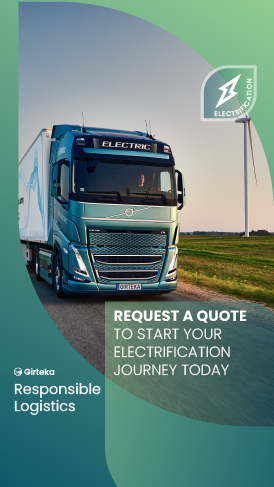With shifting consumer trends and other factors, the cold-chain logistics sector is seemingly set to only showcase growth in the coming years. Data, supported by several studies, as well as the growth in the food and beverage industry – a key player in refrigerated logistics – shows a positive compound annual growth rate (CAGR) for the next few years for cold-chain transportation.
But where do those opportunities lie in the next few years?
Stable growth
Demand for reefer trailers fluctuates quarterly in Europe, partially down to peak seasons that are dependent on food production. While various factors, including weather, can push the peak seasons back and forth, the general rule of thumb that peak demand for cold-chain logistics occurs between June and October, which is also incidentally is in parallel with the peak travel season between July and August. Another peak in demand could be seen between November and May, driven by various factors, including the winter harvest.
Still, 2020 was a year like no other and demand for temperature-sensitive transportation dipped lower compared to a year prior, according to Beroe data. But as the months have rolled on, demand once again recovered by Q4 2020 and reached the same level as seen in 2019, showcasing that despite a black swan event, demand for cold-chain logistics solutions is resilient and is quick to recover once the situation stabilizes.
On the other hand, diesel prices have continued to steadily rise throughout the year. While not at the same level as seen during the last peak in January 2020, the price has begun its upward journey since its lowest point in May 2020. Cold-chain logistics are more exposed to diesel price changes, as the reefer trailers control the temperature with a diesel engine mounted on the trailer.
Increased costs can lead to profit margins on a lane going down. If worst comes to worst, it could lead to a lane being unprofitable and result in a chain reaction throughout the supply chain. If there is a need to re-negotiate pricing between a customer and a supplier that could take up extra time before cargo is ready to move – and when speaking about cold-chain logistics, time is of the essence.
Post-crisis growth opportunity
At the same time, concentrating on profit margins in a volatile time such as this could be a risky strategy. According to McKinsey & Company, focusing on achieving “escape velocity from the crisis when the time comes,” read the article by the consulting firm, is a lesson to be learned from past crises. The so-called escape velocity has allowed logistics companies in the past to outperform their competition following the global financial crisis of 2008, as one example. Research pointed out that through-cycle outperformers managed to achieve better returns to shareholders, higher profit and revenue between 2013 and 2018.
McKinsey also pointed out that the key to their success was focusing on investment in a company’s core business and taking existing competencies to the next level, as well as improving efficiency and the development of technological platforms. Another key to open the doors of success was expanding the business geographically, in part enabled by Mergers & Acquisitions (M&A).
There is no doubt that cold-chain logistics, including pharma logistics, have been a core business at Girteka Logistics. In 2020, the company completed 820,000 full truck load (FTL) deliveries, out of which, 35% were fresh & frozen food products. An additional 5% and 3% were excise and pharma goods, respectively, meaning 43% out of the total FTL deliveries were done utilizing refrigerated trailers and naturally, indicating that it is a core business at Girteka Logistics.
Despite a shaky 2020, as border closures and the virus have disrupted supply chains and livelihoods across Europe, the logistics company made use of the opportunity to begin a transformation of its business. Digitalization was identified as the name of the game, as an ambitious goal was set: to fully digitalize Girteka Logistics’ operations by 2025. The past year was the beginning of that journey, as partnerships with SAP, to establish a digital framework, and Novigo, to take its digitalization and innovation processes to the next level.
While the acquisitions were completed previously, Girteka Logistics also expanded in the Scandinavian market by acquiring two companies involved in the cold-chain logistics processes in the region. Firstly, the company completed the acquisition of Thermo-Transit, a Denmark-based logistics company, becoming the sole shareholder in 2018, after purchasing 40% of the company’s shares in 2016. Furthermore, Girteka Logistics acquired 60% of Thermomax, a Norway-based logistics company in 2013. Thus, while the current crisis has not resulted in the company venturing into M&As, the seeds of growth were planted previously, with the rewards set to be reaped as the continent opens up once again.
Hot or cold crisis?
Yet the question is, how shaky was 2020 for cold-chain logistics? After all, 2019 was a record-breaking year for tourism and such establishments as hotels or restaurants do require food and excise goods – and 2020 flipped the script.
It was quite shaky, as reported by Bloomberg in early June 2020, the capacity at cold-storage facilities across Europe was filling up and had little ice to spare for temperature-sensitive products. Despite that fact, food manufacturers had to look for places to store and in turn, transfer those products from the manufacturing site to a location where it would either continue the journey towards its intended retail point or a site where it could be stored until sufficient demand would return.
Nevertheless, it is not all doom and gloom. As several research studies pointed out, the cold storage sector is looking at a period of growth following a turbulent 2020, per CBRE, the global cold storage sector is set to grow at a CAGR of 4.5% by 2023. Market Data Forecast pointed out that while the pandemic has had its impact on all supply chains in Europe, including the cold-chain logistics, growth is still predicted for the sector. The growth will primarily be driven by changing consumer behavior, including more attention to avoid food wastage, which cold-chain transportation and storage contribute to, as the solutions increase the longevity of products. Furthermore, consumers pay an ever-increasing amount of attention to the quality of food they consume, which is once again ensured by making sure that food is transported properly.
Another obvious reason for the growth is the growing global population, including within the European Union (EU). According to Eurostat data, as of 2019, the population within the EU is set to grow until 2030, when it will begin to slowly decrease starting that year. But caution should be advised, as a demographic outlook study, published in March 2021, the European Parliament noted that while “the actual implications of the coronavirus pandemic for demography are not yet measurable, surveys are already pointing to an increase in the number of deaths compared to similar periods from previous years.” Furthermore, the pandemic “has led to slightly higher mortality rates and possibly to lower birth rates, mainly owing to economic reasons such as increased unemployment and poverty.”
With that in mind, competition could heat up, rather than cool off. An edge between competitors could be gained by offering a better product, including customer support following his order. For example, Girteka Logistics utilizes a fleet of thermo-mapped and annually calibrated semi-trailers for its cold-chain transport solutions, as well as temperature monitoring on loading. To ensure safety and quality, as well as peace of mind, the company provides its customers with the ability to have real-time visibility of their orders, with 24/7 online support.
Independency of pharmaceutical logistics
Food & excise goods are not the only products that have to be kept cool. Pharmaceuticals and their logistics are also a complex supply chain, that was at first, thrown into complete chaos as COVID-19 broke out across Europe.
“Some goods, like disinfectant, face masks, and safety gowns were now at the forefront of the whole pharmaceutical logistics chain. At the same time, we also had to make sure timely delivery of temperature-sensitive produce to health care sites, pharmacies and in turn, end-consumers,” commented Diana Končienė, a Business Development Team Lead at Girteka Logistics. “Thus, during the first wave of quarantine, pharmaceutical companies had to make extra effort to make sure their supply chain is in order, to ensure smooth supply to their customers while at the same time making sure that the quality of their products is up to scratch, which in turn, created a demand for a trusted pharmaceutical logistics partner,” she added.
At the same time, there was little time or desire to risk, and tenders were postponed, as the lookout for new suppliers was seemingly halted. “Companies made do with what they had – nobody wanted to risk by signing a new contract with a logistics partner that they did not know and take a leap of fate,” Končienė noted.
In terms of fluctuations in the market, the Business Development Team Lead mentioned that there were little to none, as temperature-sensitive pharmaceuticals are independent of the situation in the general market. Still, demand increased, yet at the same time, customers were cautious in filling the gaps. “They wanted to minimize any potential risks associated with new suppliers for their logistics needs,” she commented.
According to Končienė, growth is stable in the pharmaceutical logistics sector. “The client portfolio within Girteka Logistics has grown stably. All in all, the demand for cold-chain transportation solutions is growing due to increased consumption of pharmaceutical products, the desire to make sure that the goods are delivered qualitatively, and the development of new drugs,” Končienė concluded, adding that “Girteka Logistics sees a lot of potential to grow in the pharmaceutical logistics sector.”
Fresh & frozen food transportation is undoubtedly a very large market, including the amount of fresh produce Girteka Logistics transports annually. Out of the 820,000 full truck load (FTL) deliveries in 2020, 35% of them were dedicated to fresh & frozen food goods. Yet pharma logistics are also poised to only grow and make up an important part of cold-chain logistics, as new a plethora of drugs that have to be transported in a temperature-controlled environment are developed by pharmaceutical companies. With a fragmented market within Europe, the opportunity to grow from a company’s perspective will come as the continent once again opens its borders and businesses will welcome customers with open arms.





